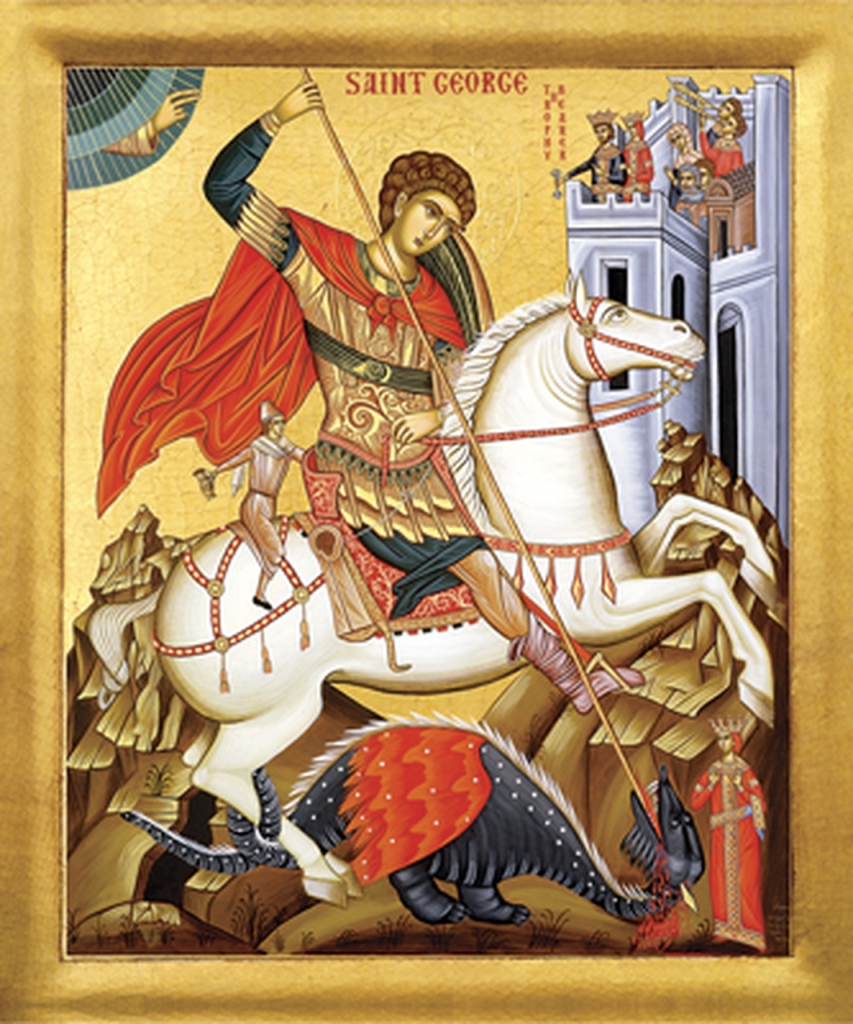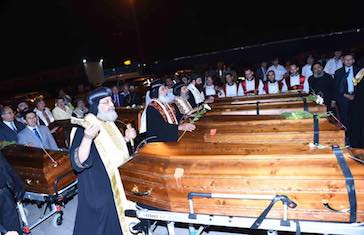A Sermon Preached on The Fourth Sunday of Easter (commonly known as Good Shepherd Sunday), which is also the Sunday before St George’s Day (23 April), at
The Anglican Church of St. Thomas the Apostle, Kefalas, Crete
on the 21st of April 2024.
The readings were Acts 4:5-12, Psalm 23, and John 10:11-18, and we sang two paraphrases of Psalm 23 (“The Lord’s My Shepherd” and “The King of Love My Shepherd Is”) and two patriotic hymns (“I Vow to Thee, My Country” and “And Did Those Feet in Ancient Times”).

This morning I am doing what the kids call a “mashup” where you take two things that are not necessarily related and see what happens when you put them together – in this case, Good Shepherd Sunday and the Festival of St George, Patron Saint of England. I feel obliged to talk a bit about St George after having had a brief presentation about St David of Wales around March 1st, and a discussion of St Patrick of Ireland around March 17th; at this rate I will have to preach about St Andrew come November 30th. In any case, I have never preached about St George before, so i may as well now, eh?
There are many things we can say with certainty about St George and his patronage of England.
- He was not English (I know, shocking).
- His name is Greek, Γεώργιος.
- The first documented mention of him was in the late 5th century, where he is in a list of martyrs whose names are known but who actions are otherwise known only unto God.
- Despite his story being unknown in Rome, a century later, in the early 6th century, his relics are associated with a church in Lydda, now called Lod, near where the modern Ben Gurion airport is in Israel.
- A story of his life was written in the late 6th century or early 7th century. It suggested that he was a Roman soldier from Cappadocia in Anatolia, and that he was put to death for his faith around the year 304 on April 23rd in the Diocletian persecutions. However, as this was written 200-300 years after his supposed death, these facts may be more imaginative than rooted in historical fact.
- He did not kill a dragon. That only became part of the story in the 12th century. Powerful image, though, eh?
- As a soldier saint he was associated with a St Theodore Toro, who was depicted killing a dragon, representing evil. The two soldier saints were often depicted together, and George was illustrated killing human enemies of God. In time Theodore and the human foes dropped out, leaving just George lancing the snakey one.
- Because he was a soldier, he became a patron saint of soldiers, especially those in the Crusades. The plain red on white cross was the flag and shield of the crusaders, and this became associated with St George.
- The Golden Legend of 1260 told an elaborate story of George killing a dragon in Libya. A town there was besieged by dragon, and the townspeople bought it off by feeding it two sheep a day. They eventually went through all their livestock, and so had to start offering children. Finally the king’s own daughter was obliged to offer herself (you cannot have a story about a dragon without a princess, right?). Just as the princess was about to be eaten, George shows up, woulds the dragon with his lance, and then chops off its head. In some versions of the story the town then converts to Christianity, and George marries the princess. This story gave rise to all kinds of paintings and etchings.
- When Edward III of England founded the Order of the Garter in 1348, he made George its patron saint, and built the Chapel of St George in Windsor Castle as the home of the order. They adopted the design of the red cross on the white background, whether on shield or flag, as the symbol of the English king, and hence of the English realm. This red on white design began to be used to represent England.
- Shakespeare immortalized St George in Henry V: “Cry ‘God for Harry, England, and Saint George!” Of course, fans of the Bard know that he was supposed to be born on April 23.
- George is immensely popular throughout Europe and beyond. In Georgia there are supposedly 365 churches named in his honour, one for every day of the year; most Georgians think the country was named after St George (although the country’s name probably comes from Persian). Malta, Portugal, Bosnia, Aragon, Austria, Catalonia, as well as Brazil and Ethiopia, all have a special devotion to the saint.
- In Great Britain/the UK and Canada we have had six kings named George, and if you live long enough you might see Prince George of Wales ascend the throne as King George VII.
- Greece, of course, has had two King Georges, the first one of which was assassinated, and the second of which was deposed, restored by a dictatorship, exiled after the Nazi invasion, and then restored by the Allies.
- To sum up, there is very little we can really say with any certainty, except that he probably existed, and was remembered because he was put to death for his faith. He is like hundreds of thousands of martyrs through the centuries – a name.
If this is so, we can say further that St George is like Jesus. Like Jesus, he laid down his life. By what power or by what name did he do this? He stood before his persecutors by the name of Jesus Christ of Nazareth, who had been crucified, but whom God raised from the dead. George, like all martyrs, witnessed to the hope of the resurrection in Jesus Christ – indeed, the term “martyr” means “witness”. He hoped that, as Jesus was, he would be also. He would have known Jesus as the stone that was rejected but had become the cornerstone of the whole building of God, and his place as a stone within it.
This is an era of martyrs.
Here is a random list of some recent ones.
- 2004 Kim Sun-il, a South Korean translator and Christian murdered by the terrorist group Jama’at in Iraq.
- 2005 Ghorban Tourani was murdered in Iran for having converted to Christianity and having started a church in
- 2008 Son Jong-nam, North Korea, murdered for bringing Bibles into the country.
- 2008 Gayle Williams, or British and South African citizenship, was killed by the Taliban in Kabul as she worked for a Christian social service agency.
- 2015 Twenty Egyptian Coptic Christians killed by the Islamic State, as well as a Ghanian man named Matthew Ayariga.
- On Easter Sunday 2019 three Christian churches in Colombo, Sri Lanka , were bombed. Over 238 people were killed, including dozens of children.
There are many more, so many that their names barely register when reported in the media. And yet, their faith and actions are known to God.
And us?
We who do not live with the fear of persecution are called upon to defend the dignity of all peoples. For whatever religion they are persecuted, they are still people made in the image of God and are the children of God for whom Christ died, and alongside whom Christ died. Inasmuch as Christ was vindicated by being raised from the dead, so will they be honoured for their faithfulness. All religions seem to have had violent extremes, and terrorists have often used their radicalized faith to justify killing others. Whatever the extremes, the mainstream leaders of all the great religions have always emphasised the protection of the vulnerable and respect for others.
We pray that God will work through politicians and diplomats, armed forces and the United Nations, non-governmental agencies and people of good will, to end violence and war against people on account of their faith. We know that all of these people and institutions are fragile vessels and often are compromised, yet they are the means we have to achieve peace. May we remember all those whose faith is known only unto God, and may we, empowered by the faith of the resurrection, work to save those who continue to be challenged and persecuted, as Γεώργιος was, as our Good Shepherd, Jesus of Nazareth, was. May all the witnesses of God rest in peace, and at Christ’s coming, hear his voice, and rise in glory.


